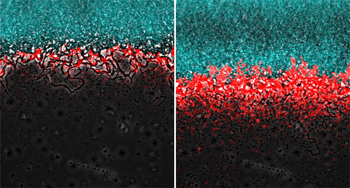Bacteria Recruit Other Species with Long-Range Electrical Signals
January 17, 2017
By Kim McDonald

Electrical messages sent by biofilms (in green, at left) recruit new members (in red, at right) to the microbial community.
Suel Lab, UC San Diego
Biologists at UC San Diego who recently found that bacteria resolve social conflicts within their communities and communicate with one another like neurons in the brain have discovered another human-like trait in these apparently not-so-simple, single-celled creatures.
Bacteria living in diverse communities called "biofilms" create what are essentially electronic advertisements, the scientists report in a paper published in this week's issue of the journal Cell,by sending long-range electrical signals to other bacterial species that can lead to the recruitment of new members to their biofilm community.
"We've discovered that bacterial biofilm communities can actively modulate the motile behavior of diverse bacterial species through electrical signals," said Gürol Süel, a professor of molecular biology, Associate Director of the San Diego Center for Systems Biology and Howard Hughes Medical Institute – Simons Faculty Scholar at UC San Diego, who headed the research effort. "In this way, bacteria within biofilms can exert long-range and dynamic control over the behavior of distant cells that are not part of their communities."
Biofilms are communities of bacteria and other microorganisms that form thin structures on surfaces—such as the tartar that develops on teeth—that are highly resistant to chemicals and antibiotics. Because not much is known about how they form, recruit other microorganisms and resist attack, such information about their behavior has practical applications—from preventing tartar formation on teeth to avoiding Staph infections in hospitals.
But the idea that bacteria ensconced in their protective biofilm villages behave like sophisticated marketing agents—advertising the presence of their communities by sending out electronic messages—overturns fundamental beliefs that both scientists and the general public have about these supposedly lowly creatures.
"Our study shows that bacteria living in biofilm communities do something similar to sending electronic messages to friends," said Jacqueline Humphries, a doctoral student working in Süel's laboratory and the first author of the paper. "In fact, the mechanism we discovered is general. We found that bacteria from one species can send long-range electrical signals that will lead to the recruitment of new members from another species. As a result, we've identified a new mechanism and paradigm for inter-species signaling."
The UC San Diego biologists discovered in their laboratory work, which integrated experiments with mathematical modeling, that a biofilm composed of a single species of Bacillus subtilis bacteria was able to recruit bacteria of a different species—in this case, Pseudomonas aeruginosa—through electrical signaling.
Using microfluidic growth chambers, the biologists documented the process by which potassium ion electrical signaling generated by B. subtilis biofilms attracted distant cells within the chambers to the edge of electrically oscillating biofilms.
Süel and his team of graduate students and postdoctoral fellows discovered in the summer of 2015 that oscillations within biofilm communities resolved a social conflict between individual cells that were cooperating, but also had to compete for food.
Bacteria at the outer edge of the biofilm are closest to nutrients necessary for growth and could starve the sheltered interior cells. But the scientists discovered that oscillating biofilms develop what they call "metabolic codependence" by putting the brakes periodically on the outer cells' growth to give the interior cells access to nutrients.
Not long after, Süel and his team discovered that bacteria living in biofilm communities communicate with one another electronically through proteins called "ion channels," an electrical signaling method similar to that used by neurons in the human brain.
Their most recent discovery—that bacteria in biofilms can recruit other species with long-range electrical signals—could turn out to be not only the most surprising of the team's findings, but perhaps the most significant for our understanding of how bacteria impact human health.
"Our latest discovery suggests that the composition of mixed species bacterial communities, such as our gut microbiome, could be regulated through electrical signaling," said Süel. "It may even be possible that bacterial and human gut cells can interact electrically within the human gut. Our work may in the future even lead to new electrical-based biomedical approaches to control bacterial behavior and communities."
Other co-authors of the paper were biologists Jintao Liu and Arthur Prindle, postdoctoral researchers in Süel's laboratory; biologist Fang Yuan, a doctoral student in the lab; UC San Diego physicist Liyang Xiong; Heidi Arjes of Stanford University and Lev Tsimring, a research scientist and associate director of UC San Diego's Biocircuits Institute.
